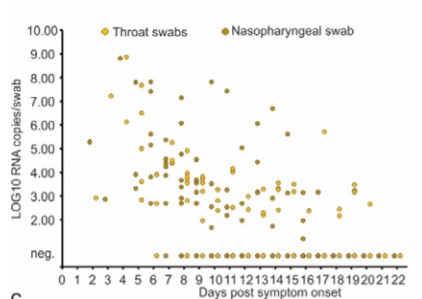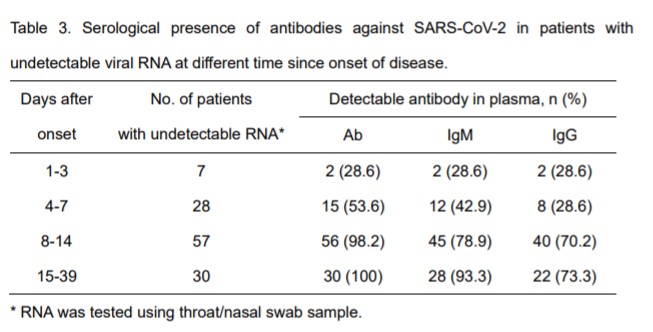EPI 101 thread on sensitivity and specificity, plus its application to #COVID19 screening. For those who want a refresher!
The way we summarize the accuracy of a test (such as RT-PCR on a #coronavirus throat swab) is with two quantities: sensitivity and specificity. 1/12
The way we summarize the accuracy of a test (such as RT-PCR on a #coronavirus throat swab) is with two quantities: sensitivity and specificity. 1/12
SENSITIVITY measures how well we can pick up patients with disease. Imagine a nasal swab from someone with SARS-CoV-2 infection. Sensitivity is the probability this sample will test positive. 2/12
With RT-PCR, the specimen is declared positive if viral RNA is detected. We have seen that patients with COVID19 seem to have high viral loads in their throats. Thus it is relatively easy to detect virus, and so the test is highly sensitive. 3/12
https://www.medrxiv.org/content/10.1101/2020.03.05.20030502v1.full.pdf">https://www.medrxiv.org/content/1...
https://www.medrxiv.org/content/10.1101/2020.03.05.20030502v1.full.pdf">https://www.medrxiv.org/content/1...
When sensitivity is low, we risk getting FALSE NEGATIVES. These would be swabs from which no virus is detected even though the person is infected. This could occur if the specimen was degraded in some way, virus didn& #39;t amplify well, etc. 4/12
Importantly, patient viral load changes over the course of illness, and may be different for asymptomatic vs. symptomatic infections. Thus, while we try to distill sensitivity down to a single number, in reality it may vary with time since infection or severity of symptoms. 5/12
SPECIFICITY measures how well we rule out infection for people who are tested but aren& #39;t infected. Imagine a nasal swab from someone without SARS-CoV-2 infection. This should come back negative on RT-PCR. Specificity measures how often these come back negative. 6/12
Because RT-PCR measures viral RNA, it would be rare for someone to test positive if they aren& #39;t actually infected. It could happen, though, if there were contamination in the lab. In general, RT-PCR is highly specific because there are few FALSE POSITIVES. 7/12
Of course not all tests are highly sensitive and specific. Imagine a rapid test to detect SARS-CoV-2 antibodies. This would be much cheaper and easier to do than RT-PCR. But think about how antibodies develop over time... 8/12 https://www.medrxiv.org/content/10.1101/2020.03.02.20030189v1.full.pdf+html">https://www.medrxiv.org/content/1...
Before a robust immune response has developed, we will return many false negatives. A low sensitivity test wouldn& #39;t be very good at detecting early infections, but detecting these infections is important for containment. 9/12
Now imagine a test with poor specificity. You could have a (very bad) antibody test that turned up a false positive for everyone who had been infected with a mild coronavirus, like the ones that cause the common cold. 10/12
The impact of a test with poor specificity is that you will need to intervene somehow on all of these false positives (further testing, quarantine), and this has costs. This includes emotional costs since now that person thinks they have COVID19. 11/12
I hope this was a helpful refresher on sensitivity and specificity!
If you are interested in learning more about sensitivity and specificity of screening tests, check out this useful guide. END 12/12
http://sphweb.bumc.bu.edu/otlt/MPH-Modules/EP/EP713_Screening/EP713_Screening_print.html">https://sphweb.bumc.bu.edu/otlt/MPH-...
If you are interested in learning more about sensitivity and specificity of screening tests, check out this useful guide. END 12/12
http://sphweb.bumc.bu.edu/otlt/MPH-Modules/EP/EP713_Screening/EP713_Screening_print.html">https://sphweb.bumc.bu.edu/otlt/MPH-...
*While my intent was to teach the concepts of sens/spec more than summarize actual tests, I am
updating the thread to cite a paper showing LOW sensitivity (71%) of RT-PCR at initial presentation. Patients eventually tested positive 1 to 7 days later.
https://pubs.rsna.org/doi/pdf/10.1148/radiol.2020200432">https://pubs.rsna.org/doi/pdf/1...
updating the thread to cite a paper showing LOW sensitivity (71%) of RT-PCR at initial presentation. Patients eventually tested positive 1 to 7 days later.
https://pubs.rsna.org/doi/pdf/10.1148/radiol.2020200432">https://pubs.rsna.org/doi/pdf/1...

 Read on Twitter
Read on Twitter



